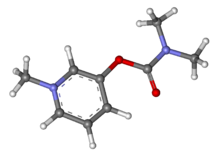Pyridostigmine
 | |
 | |
| Clinical data | |
|---|---|
| Trade names | Mestinon, others |
| AHFS/Drugs.com | Monograph |
| MedlinePlus | a682229 |
| Pregnancy category |
|
| Routes of administration | By mouth, intravenous |
| ATC code | |
| Legal status | |
| Legal status | |
| Pharmacokinetic data | |
| Bioavailability | 7.6 +/- 2.4% |
| Elimination half-life | 1.78 +/- 0.24hrs |
| Excretion | kidney |
| Identifiers | |
| |
JSmol) | |
| |
| |
| (verify) | |
Pyridostigmine is a medication used to treat
Common side effects include nausea, diarrhea, frequent urination, and abdominal pain.
Pyridostigmine was patented in 1945 and came into medical use in 1955.
Medical uses
Pyridostigmine is used to treat muscle weakness in people with myasthenia gravis or forms of congenital myasthenic syndrome and to combat the effects of curariform drug toxicity. Pyridostigmine bromide has been FDA approved for military use during combat situations as an agent to be given prior to exposure to the nerve agent Soman in order to increase survival. Used in particular during the first Gulf War, pyridostigmine bromide has been implicated as a causal factor in Gulf War syndrome.[7][8]
With pyridostigmine classified as a type of parasympathomimetic, it can be used to treat underactive bladder.[9]
Pyridostigmine sometimes is used to treat orthostatic hypotension.[10] It may also be of benefit in chronic axonal polyneuropathy.[11]
It is also being prescribed 'off-label' for postural orthostatic tachycardia syndrome as well as complications resulting from Ehlers–Danlos syndrome.[11][12]
Contraindications
Pyridostigmine bromide is contraindicated in cases of mechanical intestinal or urinary obstruction and should be used with caution in patients with bronchial asthma.[13][14]
Side effects
Common side effects include:[13]
- Sweating
- Diarrhea
- Nausea
- Vomiting
- Abdominal cramps
- Increased salivation
- Tearing
- Increased bronchial secretions
- Constricted pupils
- Facial flushing due to vasodilation
- Erectile dysfunction
Additional side effects include:[13]
- Muscle twitching
- Muscle cramps and weakness
Mechanism of action
Pyridostigmine inhibits acetylcholinesterase in the
The ACh diffuses across the synaptic cleft and binds to receptors on the post synaptic membrane, causing an influx of sodium (Na+,) resulting in depolarization. If large enough, this depolarization results in an action potential. To prevent constant stimulation once the ACh is released, an enzyme called acetylcholinesterase is present in the endplate membrane close to the receptors on the post synaptic membrane, and quickly hydrolyses ACh.
Names
Pyridostigmine bromide is available under the trade name Mestinon (
References
- ISBN 9789241547659.
- S2CID 244530010.
- ^ a b c d e f g h i "Neostigmine Bromide". The American Society of Health-System Pharmacists. Archived from the original on 21 December 2016. Retrieved 8 December 2016.
- ISBN 9783527607495. Archivedfrom the original on 2016-12-20.
- hdl:10665/325771. WHO/MVP/EMP/IAU/2019.06. License: CC BY-NC-SA 3.0 IGO.
- ^ "Competitive Generic Therapy Approvals". U.S. Food and Drug Administration (FDA). 3 March 2023. Retrieved 6 March 2023.
- PMID 18332428.
- ^ Steenhuysen, Julie (March 10, 2008). "Gulf War illness linked to chemical exposure-study". Reuters.
- S2CID 244530010.
- S2CID 22855759.
- ^ S2CID 22855759.
- S2CID 20405336.
- ^ a b c Mestinon | Home Archived 2008-05-13 at the Wayback Machine
- ^ Mestinon Official FDA information, side effects and uses Archived 2008-05-24 at the Wayback Machine
External links
- "Pyridostigmine". Drug Information Portal. U.S. National Library of Medicine.
